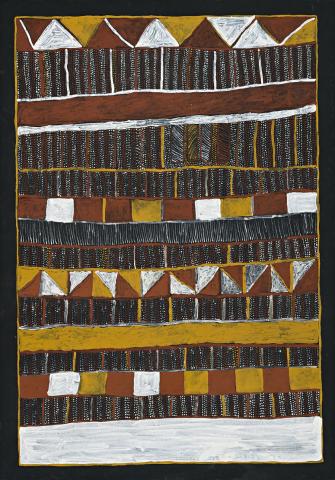UNTITLED, 2000
KUTUWULUMI PURAWARRUMPATU (KITTY KANTILLA)
natural earth pigments on linen
127.0 x 89.0 cm
inscribed verso: artist's name and Jilamara Arts and Crafts cat. KKLC007
Jilamara Arts and Crafts, Melville Island (stamped verso)
Private collection, Melbourne
So aptly named the 'Queen of Jilamara' the late Kitty Kantilla (Kutuwulumi Purawarrumpatu) brought the art of the Tiwi Islands to contemporary acclaim. Informed by traditional knowledge inherited from her father, Kantilla's cultural identity is central to her accomplished aesthetic. 'As a young girl she learnt by watching her father paint his special jilamara (design) on faces, bodies and objects, and by experiencing dramatic spectacle of Pukumani ceremonies with sets of individual kinship dances and songs, differentiated face and body designs, and huge fully decorated tutini and objects.'1 Originally a sculptor of tutini (funerary poles) and figures, in 1988 sixteen of her remarkable ironwood carvings were shown in Carved Wooden Sculptures by Tiwi Women from Paru at Aboriginal Artists Gallery in Sydney (see previous lot in this auction for an example of her sculptures). These distinctly modern works captured non-Tiwi audiences and swiftly established her reputation as a leading artist.
By the mid-1990s, Kantilla had made a departure from the vigorous carving involved with sculpture, to focus on two-dimensional works on paper and canvas. In reverence to the body painting and tutini designed for the Pukumani ceremony, in Untitled, 2000, Kantilla applied natural earth pigments directly to a black primed ground. Traditionally when preparing tutini for ceremony, artists gently burnt the carved surface, giving it a ripened black appearance. To afford this charred black longevity, typically a natural fixative was then applied. The current work is a definitive and important representation of this style. Providing a bold underlay to the textured bands of colour and geometric sequences, Kantilla's deliberate use of black as a ground to adornment is startling.
In the catalogue to Kantilla's 2007 National Gallery of Victoria retrospective Judith Ryan describes Kantilla's approach: 'She is able to distil and pare back figurative elements so that her work, like an analytic cubist still life, reduces form to structure and partakes of the quality of inwardness. The balancing patterns of red, yellow and white ochre in counterpoise with constant rows of alternating ochre dots on black or white, results in work of overriding presence and great beauty, borne of restraint and imbued with adagio rhythm.'2
1. Ryan, J., Kitty Kantilla, National Gallery of Victoria, Melbourne, 2007 p. 82
2. ibid.
